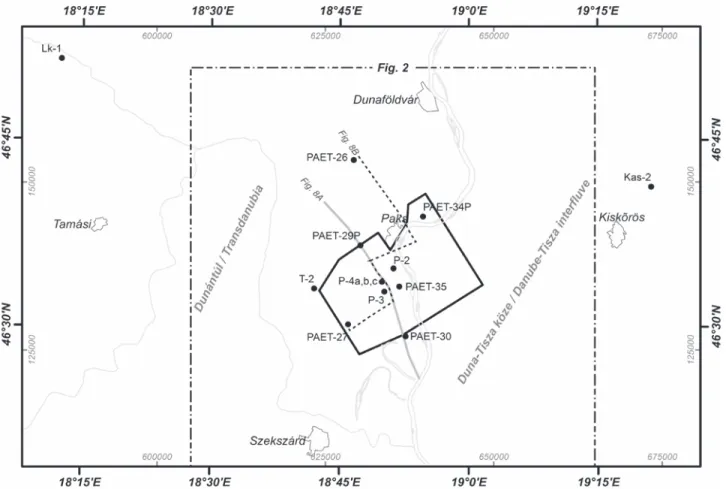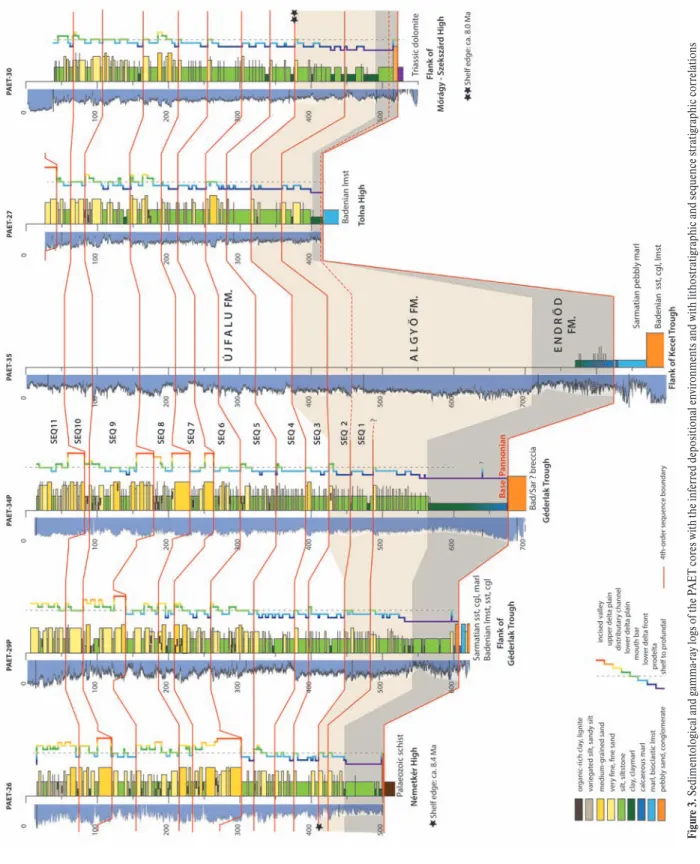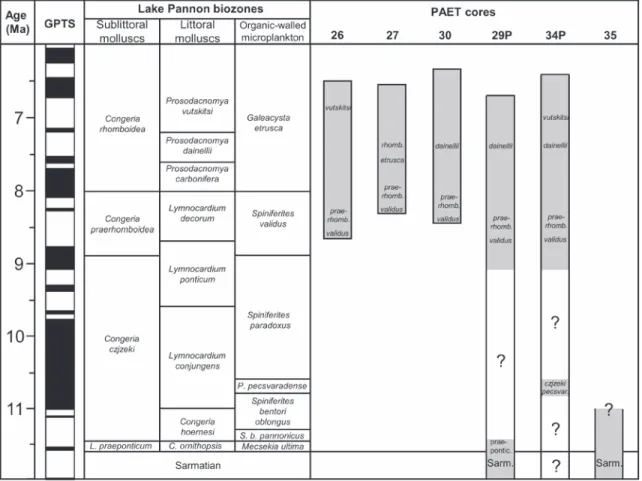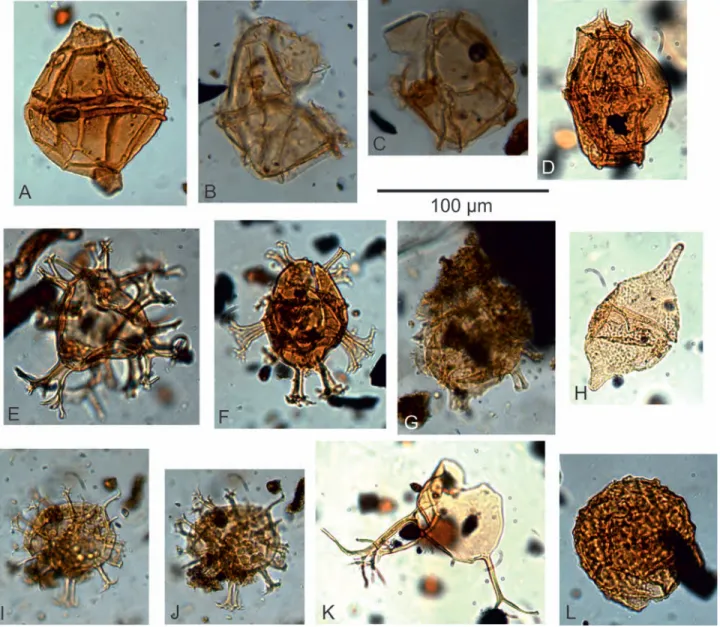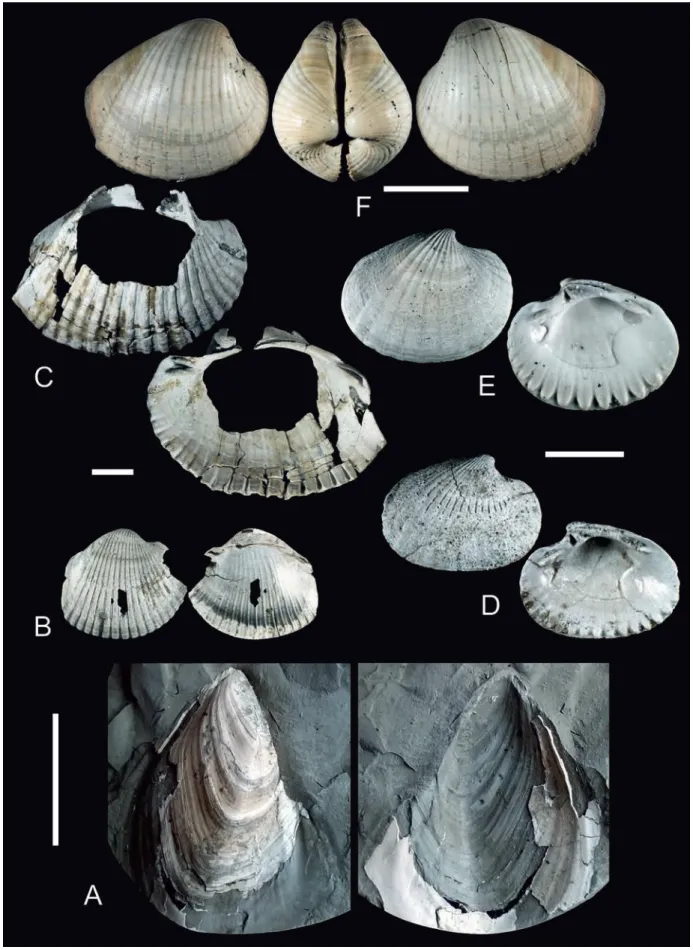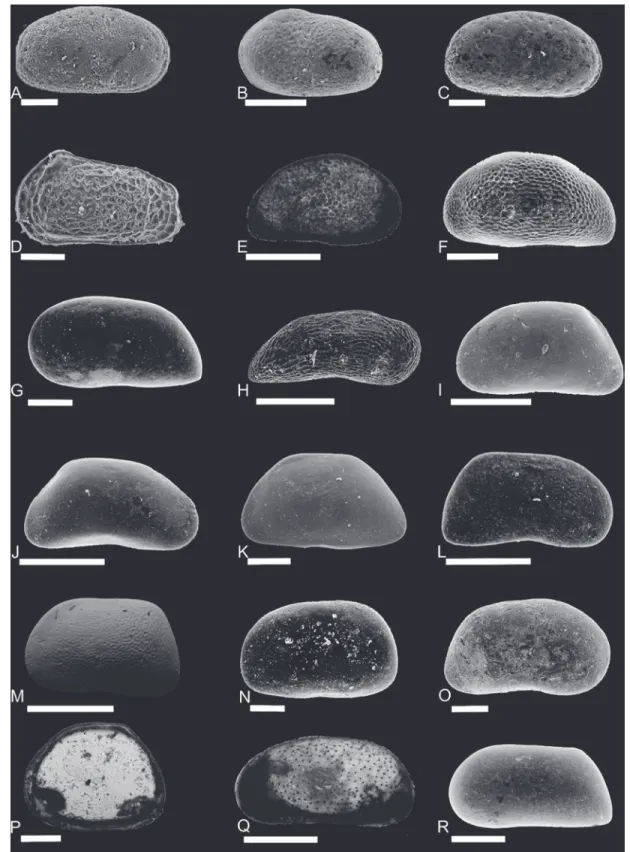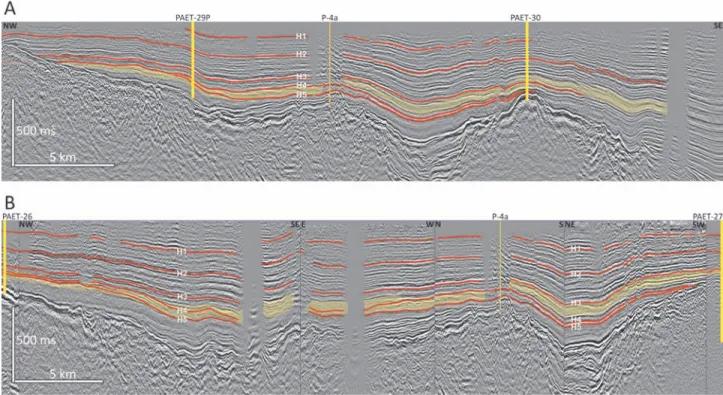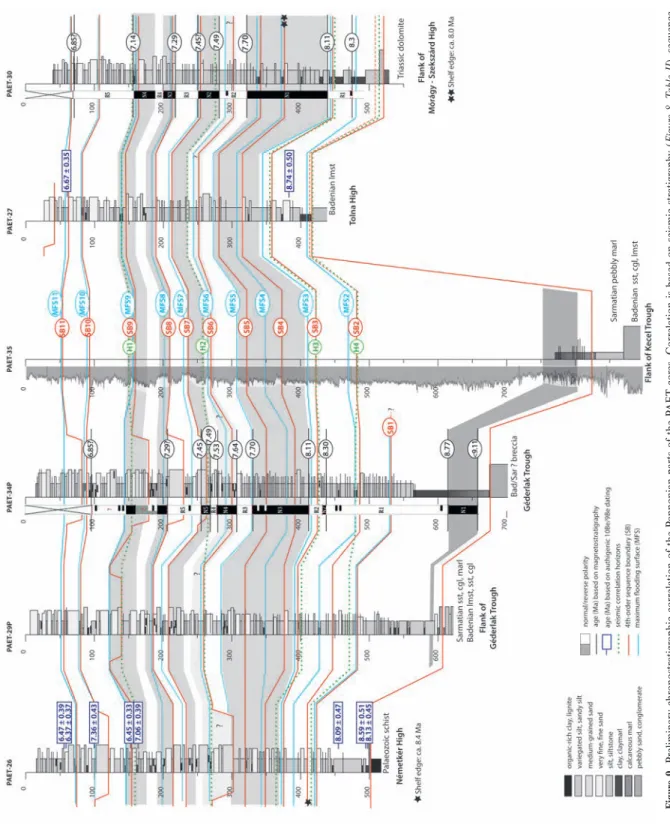Towards a high-resolution chronostratigraphy and geochronology for the Pannonian Stage:
Significance of the Paks cores (Central Pannonian Basin)
MAGYAR, Imre1,2, SZTANÓ, Orsolya3, SEBE, Krisztina4, KATONA, Lajos5, CSOMA, Vivien3, GÖRÖG, Ágnes3, TÓTH, Emőke3, SZUROMI-KORECZ, Andrea2, ŠUJAN, Michal6, BRAUCHER, Régis7, RUSZKICZAY-RÜDIGER, Zsófia8, KOROKNAI, Balázs9,
WÓRUM, Géza9, SANT, Karin10, KELDER, Nick10, KRIJGSMAN, Wout10
1MTA-MTM-ELTE Research Group for Paleontology, Budapest; 2MOL Hungarian Oil and Gas Plc., Budapest; immagyar@mol.hu; kaszuro@mol.hu; 3Eötvös Loránd University, Budapest; sztano@caesar.elte.hu; csoma.vivien7@gmail.com; gorog@ludens.elte.hu; tothemoke.pal@gmail.com; 4University of Pécs; krisztina.sebe@gmail.com; 5Natural History Museum of the Bakony Mts., Hungarian Natural History Museum, Zirc; finci@nhmus.hu; 6Comenius University in Bratislava; miso@equis.sk; 7Aix-Marseille University, Aix-en-Provence; braucher@cerege.fr; 8Hungarian Academy of Sciences, Budapest; rrzsofi@geochem.hu; 9Geomega Ltd., Budapest; koroknai@geomega.hu; worg@geomega.hu;
10Utrecht University; karin.sant@gmail.com; n.a.kelder@gmail.com; W.Krijgsman@uu.nl
149/4,351–370., Budapest, 2019
A paksi fúrómagok szerepe a pannóniai emelet nagy felbontású időrétegtanának és geokronológiájának kifejlesztésében
Összefoglalás
A pannóniai emelet kutatásában kivételes lehetőségként jelent meg, és kiemelkedő jelentőséggel bír a paksi atomerőmű bővítési folyamata során fúrt kőzetmagok sokoldalú rétegtani vizsgálata. A Paks II Atomerőmű Zrt. által 2015 és 2016 folya mán fúratott 6 magból 5 teljes (390 és 662 m közötti) vastagságban, folyamatos magmintavétellel harántolta a helybeli pannóniai képződményeket. A fúrások Paks környékén, egymástól 8–12 km távolságra mélyültek.
Mindegyik fúrás a folyótorko latoktól távol, nyílt és aránylag mély vízben képződött márgák (Endrődi Formáció), a 200 méternél nem magasabb selfperemi lejtőn lerakódott homokos kőzetliszt (Algyői Formáció), és a delta előtéri kőzet - lisztből, torkolati zátonyok homokjából, deltasíksági lignitből és homokos csatornakitöltésekből álló deltaképződ - mények (Újfalui Formáció) egymásutánját tárta fel. Két fúrómagból mágnesrétegtani, két másikból pedig autigén
10Be/9Be korhatározási módszerrel nyertünk korokat, majd a fúrások közötti szeizmikus korreláció megteremtésével kialakítottunk egy, a fúrómagok szedimentológiai és paleontológiai jellemzőitől független időrétegtani és geokronoló - giai keretet. A szarmatától kezdődő folyamatos üledékképződésnek és a legidősebb (11,6–9,1 millió éves) pannóniai rétegek összefüggő jelenlétének a bizonyítására további mikropaleontológiai vizsgálatokra lesz szükség, mert jelenleg sem a mágnesrétegtani, sem az autigén 10Be/9Be korhatározási módszer nem alkalmas a kondenzált mészmárga üledékek korolására. A 9,1 és 6,5 millió évek közötti intervallumot ezzel szemben változatos litológia és — sok esetben kivételesen jó megtartású — ősmaradványanyag képviseli a fúrómagokban. A delta üledékekben legalább 10 üledékes szekvenciát lehetett azonosítani és korrelálni; mivel ezek időtartama egyenként legfeljebb 200 ezer év lehetett, negyedrendű szek - venciáknak tekinthetők. A fúrómagokban azonosított biozónák korhatárai igen jó egyezést mutatnak az eddig használt biokronosztratigráfiai rendszerrel, lényegében megerősítik és néhány helyen pontosítják azt. A paksi PAET fúrómagok eddig soha nem látott részletességű képet nyújtanak a Pannon-tó üledékes környezeteinek és élővilágának fejlődéséről a 9,1 és 6,5 millió év közötti intervallumban.
Kulcsszavak: Pannon-tó, rétegtan, kőzetrétegtan, életrétegtan, szeizmikus rétegtan, szekvenciasztratigráfia, mágnesrétegtan, autigén
10Be/9Be kormeghatározás
Abstract
A new stratigraphic standard for the open lacustrine to deltaic Pannonian Stage is emerging from the combined sedimentological, lithostratigraphical, sequence stratigraphical, biostratigraphical, seismic stratigraphical, geo chrono - logical, and magnetostratigraphical investigations of 6 long drill cores. These were drilled by Paks II Nuclear Power Plant Plc. as a preparatory step for the construction of a new power plant near the city of Paks, Central Pannonian Basin, between 2015 and 2016. The boreholes are in a distance of 8–12 km from each other, and five of them fully penetrated the local Pannonian sequence in a thickness of 390 to 662 m. Each core includes offshore clay marl deposited far from sediment entry points (Endrőd Fm), heterolithic, sandy siltstones of a <200 m high shelf-margin slope (Algyő Fm), and several stacked deltaic deposits from prodelta silts to sandy mouth bars, heterolithics, lignite and sandy channel-fills of the delta plain (Újfalu Fm). Magnetostratigraphic investigations from two cores and authigenic 10Be/9Be dating from two others were combined by means of seismic correlation between the boreholes, and thus they provide a solid geo - chronological and chronostratigraphic basis for the interpretation of the sedimentological and palaeontological records of the cores. The continuous representation of the earliest Pannonian (11.6–9.1 Ma) in the cores needs further palaeontological investigation, as both magnetostratigraphy and authigenic 10Be/9Be dating failed to give reliable age data from the basal, condensed calcareous marls. The 9.1 to 6.5 Ma interval, however, is represented in the cores by DOI: 10.23928/foldt.kozl.2019.149.4.351
Introduction
The chronostratigraphic subdivision, correlation, and dating of the lacustrine to fluvial Pannonian Stage (Upper Miocene–Pliocene, Pannonian Basin System, PBS) has always been a problematic issue (for a historical summary, see MAGYAR& GEARY2012). In the 1980s, a series of deep wells with continuous coring were drilled in Hungary with the purpose of improving the stratigraphy and geochronol o - gy of the late Neogene sedimentary sequence of the PBS (e.g. LANTOSet al. 1992, ELSTONet al. 1994). These cores were subject to detailed biostratigraphic and magneto - stratigraphic investigations, and where present, the inter - calated volcanic layers were dated with the K/Ar method.
The resulting dataset provided a base for seismic correla - tions and sequence stratigraphic interpretations, which led to a completely new sedimentary and chronostratigraphic model of the Pannonian Stage (e.g. BÉRCZI1988, POGÁCSÁS
et al. 1988, VAKARCSet al. 1994).
Although most of the inferences from these old cores are still considered valid, multiple stratigraphic problems re - mained and hinder precise correlation and reliable dating within the non-marine basin fill: 1) the fossil record of only a few cores was published (JÁMBORet al. 1985, KORPÁS- HÓDI1992, SÜTŐ-SZENTAI2000), and biostratigraphic sub - division of the upper part of the Neogene (between ca 8–2.6 Ma) remained lacking (MAGYAR& GEARY2012); 2) serious doubts emerged concerning the reliability of magnetic polarity measurements and magnetostratigraphic interpre - ta tions because the main magnetic carrier in the cores was the diagenetically formed greigite (BABINSZKIet al. 2007);
3) the K/Ar dating often gave contradictory results and the uncertainty of the measurements was usually very high (e.g.
BALÁZS& NUSSZER1987, MAGYARet al. 1999); 4) seismic correlations were not always compatible with the biostrati - graphic and geochronological data from the cores (e.g.
TÓTH-MAKK2007); and 5) basin-wide correlation of third- order sequence boundaries remained ambiguous (cf.
VAKARCSet al. 1994, SACCHIet al. 1999, TÓTH-MAKK2007), whereas higher order sequences are too small to correlate between small depressions (SZTANÓ et al. 2013a). As a consequence, dating of the late Neogene succession within the PBS could so far only be carried out with relatively high uncertainty (+/– 0.5 Ma).
An unprecedented opportunity for testing and improving the currently used Pannonian biochronostratigraphic model arose when several-hundred-metres long Pannonian cores were drilled by Paks II Nuclear Power Plant Private Limited Company in 2015–2016 as a preparatory step for the con -
struc tion of a new power plant near the city of Paks, central Pannonian Basin. The sedimentological and palaeonto log ical analysis of the cores combined with magneto strati graphic and authigenic 10Be/9Be dating and seismic cor relations between the boreholes is resulting in a well-grounded, reliable, high- resolution chronostratigraphy for the pene trated part of the Pannonian sequence. This work is not complete yet, but here we share the preliminary results as a tribute paid to our professor, colleague, and friend, Ferenc HORVÁTH. As a member of the Scientific Advisory Board for this industrial Geological Research Program of Paks II Ltd., he was fully aware of the scientific potential and value of the cores. With the enthusiasm that was so characteristic to him, he actively supported our efforts to get access to the cores, to obtain permission for stratigraphic sampling, and to publish the results to the scientific community.
Stratigraphic background
At about the Middle–Late Miocene boundary (11.6 Ma), the PBS lost its connections to other marine Paratethyan basins, and the environment changed from restricted marine to Caspian-type brackish lacustrine with endemic aquatic biota. The several-km-thick Pannonian Stage, comprising the Upper Miocene and the Pliocene of the PBS, consists of deep water marls, turbiditic sandstones, slope shales, stacked deltaic deposits and fluvial sediments (JUHÁSZ
1992, SZTANÓet al. 2013a, b). The boundary between the major lithostratigraphic units is diachronous, reflecting the gradual advance of sand-bearing depositional systems from the margins towards the basin center (HORVÁTH& POGÁCSÁS
1988, JUHÁSZ1994).
The combination of biostratigraphy, based on endemic molluscs, ostracods, and dinoflagellates retrieved from both surface outcrops and drilling cores, with seismic strati - graphy lead to a biochronostratigraphic system, which was tentatively calibrated against the geological time scale through radiometric age measurements and magneto strati - graphic studies (for a summary, see MAGYAR & GEARY
2012). This dataset allowed the age calibration of the shelf- edge slope advancing across the PBS (VAKARCSet al. 1994, MAGYARet al. 2013).
The new studied cores, designated with the acronym
“PAET” (from the Hungarian for “Paks nuclear power plant, plot designation”) were drilled in the wide vicinity of Paks, a town located 100 km south of Budapest on the right bank of the Danube. The thickness of the Pannonian sequence is relatively small, only 400–800 m in this area, depending on various lithologies and abundant and sometimes excellently preserved fossils. In the deltaic succession, 10 sedimentary sequences were correlated between the cores; as their duration is not more than 200 kyr each, they can be regarded as 4th- order sequences. The palaeontological record of the cores shows a very good agreement with the formerly established biochronostratigraphical system. The cores provide an insight into the evolution of the sedimentary environment and the biota of Lake Pannon between 9.1 and 6.5 Ma with a so far unprecedented temporal and spatial resolution.
Keywords: Lake Pannon, stratigraphy, lithostratigraphy, biostratigraphy, seismic stratigraphy, sequence stratigraphy, magneto - stratigraphy, authigenic 10Be/9Be dating
the morphology of the highly complex Palaeo–Mesozoic basement and on the thickness of the Lower to Middle Miocene strata. Former stratigraphic data for the Pannonian of the region came from fully cored reference drillings of the 1970s–1990s, such as Lajoskomárom–1 (JÁMBOR et al.
1985), Tengelic–2 (HALMAIet al. 1982, KORPÁS-HÓDI1982, SÜTŐ-SZENTAI1982, SZÉLES1982), Kaskantyú–2 (ELSTONet al. 1994; JUHÁSZ et al. 1996, 1997; LANTOS et al. 1992;
MAGYAR et al. 1999; POGÁCSÁS et al. 1994; TÓTH-MAKK 2007), and Paks–2, –3, –4a, –4b, –4c (SZUROMI-KORECZ 1992, SÜTŐ-SZENTAI2000) (Figure 1). The lessons learnt from these old cores about the Pannonian stratigraphy of the region can be summarised as follows. 1) The deeper the base of the Pannonian Stage is, the older its basal layers are. In the local — still relatively shallow — depocenters, the oldest Pan no nian biozones are usually condensed and thus dif - ficult to identify. On the local highs, the younger Pannonian directly overlies the pre-Neogene basement with a signific - ant hiatus, and the resulted base Pannonian unconformity is easily recognisable on seismic profiles. 2) The bulk of the Pannonian sequence (the uppermost 500–600 m) represents the youngest biozones of the Pannonian Stage (Spiniferites validusand Galeacysta etruscaZones in the dinoflagellate zonation and Congeria rhomboidea and Prosodacnomya
Zones in the mollusc zonation), dated younger than ca 9 Ma (MAGYAR& GEARY2012). 3) The prograding shelf-margin slope passed by the area roughly at 8.5–8.0 Ma ago (MAGYARet al. 2013). 4) The Pannonian Stage is truncated by an erosional unconformity, separating the Upper Mio - cene from the overlying Pliocene and/or Pleistocene (MAGYAR& SZTANÓ2008).
Materials and methods
We have investigated 6 PAET cores; their location is indicated in Figures 1 and 2,and the basic data of their Pannonian intervals are summarised in Table I.
In each core, the facies, i.e. lithological variations, grain size, sedimentary structures and macrofossils, were logged from bottom to top with an accuracy of 10 cm and we inter - preted the sedimentological features in terms of depos - itional processes and environments. Based on the shift of facies, sedimentary cycles (i.e. parasequences and para - sequence sets) were determined, and their overall stacking pattern was used to cross-check correlations.
All interpretable mollusc remains were picked from the cores, and a large part of them is cleaned and determined by
Figure 1.Location map showing the discussed new stratigrapic and old hydrocarbon exploring/stratigraphic wells and the Paks 3D seismic cube (with geographical coordinates and EOV coordinate system)
1. ábra.A szövegben tárgyalt fúrások és a paksi 3D szeizmikus tömb helyszínrajza (földrajzi és EOV koordinátarendszerben)
now. Micropaleontological samples were taken from the clayey and silty intervals, and they were subject to standard procedures to obtain palynological preparates and to recover the ostracod assemblages. For the biostratigraphic evalua -
tion of molluscs and dinoflagellates, the correlation system of MAGYAR& GEARY(2012) was tentatively used. Ostracod assemblages were assigned into the biozones of SZUROMI- KORECZ(1992). The entire palaeontological material from
Figure 2.Depth map of the base Pannonian horizon (EOV coordinate system). Numbers indicate the distinguished main morphological elements (cf. Figure 6. of HORVÁTHet al. this volume)
1. Ozora trough 2. Tamási high 3. Simontornya basin 4. Németkér high 5. Sárbogárd high 6. Tengelic–Paks trough 7. Bonyhád basin 8. Tolna high 9. Szentkirály high 10. Kecel trough 11. Miske high 12. Mórágy–Szekszárd high 13. Jánoshalma high 14. Sükösd high 15. Borota basin 16. Fajsz basin 17. Újsolt trough 18. Géderlak trough
2. ábra.A pannóniai emelet talpának mélységtérképe Paks környékén (EOV koordinátarendszerben). A számok a fontosabb aljzatmorfológiai elemeket jelölik (vö.
HORVÁTHet al. 6. ábrájával ebben a kötetben)
the PAET cores was donated by Paks II Ltd. to the Hun - garian Natural History Museum, Budapest, where it is being catalogued and reposited.
Reconstruction of the base Pannonian surface and chrono - stratigraphic correlation between the cores were carried out by seismic methods. Seismic interpretation of the base Pannonian geological horizon within the study area was performed using an integrated, quality-checked geolo gical-geophysical data - set. This dataset included the Paks 3D seismic cube (acquisited in 2014), all available previous and recent 2D seismic data, as well as relevant archive wells of hydrocarbon exploration, water prospect ing, stratigraphic studies and the new PAET wells (for a summary of the dataset see Figure 4 of HORVÁTH et al. this volume). For the geological and methodological background of seismic interpretation, as well as the methods used during map construction the reader is referred to WÓRUMet al. (2015). Seismic stratigraphic cor - relations between wells PAET–26, –27, –29P, –30, and –34P were carried out on 2D seismic lines. (Correlation of PAET–
35 has not been performed yet, because this well is located off the existing 2D network.) For each well in the 2D correlation, the time/depth function of the nearby Zomba–1 hydrocarbon prospecting well was used.
Eleven samples from two cores (PAET–26, –27) were subject to authigenic 10Be/9Be dating procedure. The authi - genic 10Be/9Be dating method is based on the measurement of the ratio of 10Be versus 9Be nuclides in the authigenic phase of sediments. The radioactive 10Be (t1/2= 1.39 ± 0.01 Ma; CHMELEFF et al. 2010, KORSCHINEK et al. 2010) is formed as a cosmogenic nuclide in the atmosphere and transferred to the Earth’s surface mainly by precipitation (RAISBECKet al. 1981), where it is attached to the surface of fine grained sediments (WITTMANNet al. 2012). The stable
9Be is derived chemically from weathering rock masses. If the initial ratio (Rini), i.e. the 10Be/9Be ratio at the time of sedimentation can be constrained, the radio active decay of
10Be enables to calculate the time elapsed since sediment burial (BOURLES` et al. 1989). Accordingly, the Rinihas a key role in the age determination. It depends on the climate, drainage basin lithologies and sedimentary environment, as these factors determine the abundances of 10Be and 9Be nuclides in the water column at the time of sedimenta- tion.
The samples were processed and their 9Be content was determined using Atomic Absorption Spectrophotometer at CEREGE (Aix en Provence, France). The accelerator mass spectrometry (AMS) measurement of their 10Be/9Be ratio was performed at the French national AMS facility, ASTER (in CEREGE), calibrated against the NIST SRM 4 325 standard material with an assigned 10Be/9Be ratio of (2.79 ± 0.03)×1011. The detailed methodology and laboratory pro - cedures applied during the authigenic isotope dating is described in LEBATARDet al. (2008) and ŠUJANet al. (2016).
Five drill cores (PAET–26, –27, –30, –34P, –35) were sampled for magneto strati graphic purposes. As the results of magneto strati graphic investigations were already pub - lished by KELDERet al. (2018), the reader is referred to that paper for the description of applied methods.
The study area and location of the cores The study area has a transitional position between the typical deep basins of Transdanubia (e.g. Ozora trough, TÖRŐet al. 2012, SZTANÓet al. 2013a) and the Danube–Tisza interfluve (e.g. Kiskunhalas trough, BALÁZS et al. 2016, LEMBERKOVICSet al. 2017). The area was characterised by a moderate subsidence rate during the Pannonian. The depth map of the base Pannonian horizon (Figure 2) displays the most important morphological elements (highs and basins) of the substrata. Comparing this map to the depth map of the pre-Cenozoic basement (see Figure 6. of HORVÁTHet al. this volume), a rather similar morphological picture can be recognised. Nevertheless, as a consequence of the intense Early and Middle Miocene syn-rift sedimentation and as - sociated volcanic activity, the base Pannonian horizon, representing the post-rift phase of the PBS, displays a mor - pho logically much more smoothed, less fragmented char - acter. Furthermore, some shifts in the position of the center of certain basins/troughs can be also observed. The main depocenters during the Pannonian were the Ozora trough in the north-west, the Kecel trough in the east, as well as the Borota and Fajsz basins in the south-east, and the Bonyhád basin in the south-west (Figure 2). The depth of the base Pannonian horizon exceeds 1000–1500 m (bsl) in these basins, whereas it has a very shallow position (100–300 m Table I. Basic data of the six investigated Pannonian PAET cores
I. táblázat.A hat vizsgált PAET fúrómag pannóniai szakaszainak főbb adatai
bsl) above the neighbouring highs. In addition to these main depocenters, several minor, fault-bounded, elongated oval- shaped subbasins are also observable to the east/east-north- east of Paks (Figure 2). These are interpreted as small pull- apart basins formed during Pannonian transtension. For a detailed characterisation of the mapped faults the reader is referred to the work of HORVÁTHet al. (this volume).
Among the 6 investigated PAET wells, PAET–26 was drilled above the Németkér high, PAET–27 above the Tolna high, PAET–30 above the north-eastern spur of the Mórágy–
Szekszárd high, whereas PAET–34P was positioned in the Géderlak trough, PAET–35 in the westernmost part of the Kecel trough, and PAET–29P is located in an intermediate position on the western flanks of the Géderlak trough (Figure 2).
Description of the cores
Sedimentary facies and depositional environ ments
Profundal marls (Endrőd Formation)
The beginning of deposition, and the thickness of the profundal marls comprising the Endrőd Formation, de - pended on the initial basin floor topography. Initial basin floor relief was slightly modified by post-Pannonian de - formation (TÖRŐet al. 2012, SZTANÓet al. 2013b): highs probably became higher while lows became somewhat deeper, but the present-day morphology of the base Panno - nian surface reflects the original one. Therefore, relatively thick Pannonian successions were drilled in the Kecel and Géderlak troughs. These overlay late Middle Miocene (Sarma tian) deposits (breccias and sandstones in PAET–
29P and –34P and pebbly marls in PAET–35). In these wells, the lacustrine succession may conformably follow the Sarmatian and began with open-water calcareous marls (Tótkomlós Member of Endrőd Forma tion; Figure 3). These marls are white to light-grey, massive, and contain a lot of molluscs and ostracods. In addition to fully bioturbated beds, a dense network of burrows displayed by variations of the colour also occur. Laminated dark marls with pyrite clusters were also found rarely. The thickness of the cal - careous marl is less than 30 m. With the upward decreasing of the carbonate content, it is overlain by silty marl to siltstone, sometimes containing very thin, graded sandstone intercalations. In PAET–29P, situated on the flank of the Géderlak high, the thickness of the marl is only a few metres.
Its uppermost surface contains calcite-filled fissures, and is sharply overlain by a pebbly sand.
On local highs, the Pannonian succession uncon - formably overlies different types of basement units: Palaeo - zoic schist in PAET–26, Triassic dolomite in PAET–30, and Middle Miocene (Badenian) fossiliferous limestone in PAET–27. Lacustrine sedimentation began with either a less-than-a-metre-thick pebbly sand (PAET–26) interpreted
as a transgressive lag, or a 6-m-thick oligomictic conglo - merate of abrasional origin (PAET–30). The 5-m-thick, poorly sorted sand above the brecciated surface of the calcareous marl in PAET–29P might also be the product of wave reworking. The basal clastics or the unconformity is overlain by sand-free, mostly bioturbated, organic-rich, slightly micaceous claystones-siltstones. Pyrite clusters, solitary mollusc shells, fish scales, rarely fish skeletons and plant debris occur. These beds represent the Nagykörű Clay Marl Member of the Endrőd Formation, the thickness of which varies between 15–120 m (thinner on the highs and thicker towards the relatively deep areas; Figure 3).
Both the calcareous and clay marls are profundal lacustrine deposits. Their depositional conditions, in - cluding the water depth, slightly varied. The calcareous marls were deposited when any sort of clastic input was far enough, so the amount of suspended matter was significant - ly less than during the deposition of the clay marl. The latter indicates the approach of the clastic feeder systems, yet only mud accumulated in the area. In both settings, the de - positional depth could reach a few hundred metres. The lake bottom was well aerated for most of the time, but the occurrence of laminated intervals points to intermittent dysoxic conditions.
Slope shales and sands (Algyő Formation)
The next deposits in all wells are micaceous siltstones, commonly with frequent, very thin, very fine-grained sandy intercalations. Some sand laminae are only a few grains thick, whereas others may attain a thickness of a few mm or cm. Plane or cross lamination and convolution may occur, but no graded beds or Bouma-sequences were detected. The thickness of the sand beds and the sand/shale ratio re - peatedly increases in 20–35 m thick intervals, particularly towards the top of the formation. Scattered mollusc shells are rare, but shell beds occur repeatedly at the base of these coarsening-up units. The dip of the beds is larger than in the underlying unit, it attains 5°. In PAET–29P and –34P, 2–5 m thick folded, chaotic beds with a dip up to 50° occur; these are interpreted as slump folds (Figure 3).
These beds are representing the slope connecting the basin with the shelf. On the highs, the thickness of the slope deposits is only about 80 m, while towards the troughs it increases to 115–140 m. Taking into consideration the compaction that affected the slope deposits, these thickness values indicate 120–300 m of water depth during deposi - tion. In PAET–35, which is the structurally deepest well, the thickness of the slope deposits can be 200–250 m, cor - responding to 300–500 m water depth. Slopes with less than 100 m thickness are difficult to recognise on seismic profiles due to resolution issues (cf. UHRIN & SZTANÓ, 2012). Turbidite sandstones associated with the Algyő toe- of-slope did not deposit on the highs, and turbidites of the Szolnok Formation are also missing here. The lack of both types of turbidite system indicates a bypass zone for the clastic sediments on these slopes.
Figure 3. Sedimentological and gamma-ray logs of the PAET cores with the inferred depositional environments and with lithostratigraphic and sequence stratigraphic correlations 3. ábra.A PAET fúrómagok szedimentológiai és természetes gamma szelvénye, az üledékképződési környezetek rekonstrukciója, és a rétegoszlopok kőzetrétegtani és szekvenciasztratigráfiai korrelációja
Delta lobe shales, sands, and organic-rich beds (Újfalu Formation)
Above the slope deposits, several stacked deltaic lobes developed, comprising coarsening upwards cycles at different scales. The prodelta is represented by clean laminated mud - stones or mud-rich heterolithic facies. Shell-beds are common in the basal part of the mudstones. The increasing ratio of very fine and fine, massive or cross-laminated sandstones, slump folds, and vertical to oblique burrows indicates delta front and distal mouth bar environments. Several meter thick massive, cross-laminated to cross-bedded successions and occurrence of plane-lamination point to the proximal delta front, i.e. flood or wave-dominated mouth bars. The lower delta plain is char - acterised by heterolithics, organic-rich silts and sands, plant detritus, intense bioturbation, and mottling. Variegated clays and less than dm-thick lignite beds are common on the upper delta plain. Scattered bivalve and gastropod shells occur every where in the successions. Few metres thick, fining up series of fine, cross-bedded sand topped by organic-rich heterolithics, are inter-distributary channel fills cutting into the plain. In contrast, 10–33 m thick, cross-bedded, medium to coarse-grained sands represent major conduits of transport, which were occasion al ly deeply incised into the deltaic successions (Figure 3).
The alternation of the above facies comprises shallowing- up cycles, i.e. lacustrine parasequences. The thickness of
parasequences varies from 8 to 35 m, but no systematic change was observed. In the lower part of the succession, each cycle is made up of alternations of prodelta and delta front deposits with a well-expressed prograda tional stacking of the para - sequences, often separated by shell-beds. In the upper part, however, deltaic cycles are represented by alternations of mouth bar, lower to upper delta plain and channel-fill deposits, and aggradational to progradational stacking is characteristic.
These changes reflect the overall normal regression resulting in gradual infill of Lake Pannon. Based on the stacking pattern and the incised valley fills, at least 10 sequences were cor - related in the shallow-water sediments (Figure 3).
After the prograding slope left the area, deltaic deposits of the Újfalu Formation sedimented at least up to a thickness of 400 m. The fluvial feeder system (Zagyva Formation) is not known from the study area, due to uplift and erosion during the Pliocene to Quaternary. The Pannonian strata are directly overlain by Quaternary coarse clastics.
Fossils and biostratigraphy
All the six cores were investigated for molluscs, ostra - cods, and palynology. Apart from core PAET–35 where continuous sedimentation across the Sarmatian–Pannonian boundary can be supposed but no age-diagnostic fossils have been recovered so far, the oldest fossil association was identified in PAET–29P. At a depth of 603 m, small cardiids
Figure 4. Identified biozones in the PAET cores and their position in the biochronostratigraphic system of MAGYAR& GEARY(2012) 4. ábra. A PAET fúrómagokban eddig azonosított biozónák és azok időbeli pozíciója MAGYAR& GEARY(2012) biokronosztratigráfiai rendszerében
and Radix croatica, an index fossil (snail) of the Lymno - cardium praeponticum Zone (11.6–11.4 Ma according to MAGYAR& GEARY2012) were recognised (Figure 4).
The second oldest biostratigraphic unit identified so far, the Pontiadinium pecsvaradenseZone (10.8–10.6 Ma), was found in core PAET–34P, at a depth of 664 m (Figure 4), based on the common occurrence of Spiniferites ramosus, Pontiadinium pecsvaradense andSpiniferites bentorii pan - no nicus (Figure 5). This is in accord with the presence of the sublittoral mollusc Congeria czjzeki(C. czjzekiZone, 11.4–
8.9 Ma) at the same depth (Figures 4, 6).
Higher up in the cores of PAET–29P and –34P, as well as in the lower parts of PAET–26, –27, and –30, the sublittoral Congeria praerhomboideaZone (8.9–8 Ma) was identified by the presence of C. cf. praerhomboidea and C. zagra -
biensis. Among dinoflagellates, Impagidinium globosum and Spiniferites validusindicate the correlative Spiniferites validusZone (Figures 4, 5). In the upper part of core PAET–
27, the Congeria rhomboidea Zone and the Galeacysta etruscaZone (both <8 Ma) were found (based on the pre - sence of the sublittoral mollusc C. rhomboideaand the dino - flagellate species G. etrusca; Figures 4, 5). The other cores displayed littoral molluscs in their upper parts, such as Prosodacnomya dainelliiand P. vutskitsi, indicating the P.
dainelliiZone (7.6–7.1 Ma) in PAET–30, –29P, –34P, and the overlying P. vutskitsiZone (<7.1 Ma) in PAET–26 and – 34P (Figures 4, 6).
The biostratigraphic interpretation of the ostracods is in progress. SZUROMI-KORECZ(1992) developed an ostracod zonation for drill cores in southeastern Transdanubia
Figure 5. Stratigraphically important dinoflagellates from the PAET cores
A: Pontiadinium pecsvaradensisSütő-Szentai, PAET–34P, 639.6–639 m; B–C: Galeacysta etruscaCorradini & Biffi, PAET–27, 237.8–237.7 m; D: Spiniferites balcanicus(Baltes) Sütő- Szentai, PAET–30, 492.3–492.2 m; E: Spiniferites validusSütő-Szentai, PAET–34P, 458.06–457.96 m; F: Spiniferites virgulaeformisSütő-Szentai, PAET–30, 511–510.95 m; G: Spiniferites bentoriicf. pannonicusSütő-Szentai, PAET–34P, 663.9–663.7 m; H: Pontiadinium inequicornutumBaltes, PAET–30, 492.3–492.2 m; I–J: Spiniferites ramosus(Ehrenberg) Mantell, PAET–34P, 663.9–663.7 m; K: Achomosphaera andalousiensis Jan du Chęne, PAET–30, 477.47–477.4 m; L: Impagidinium globosumSütő-Szentai, PAET–29P, 405.5–405.4 m 5. ábra.Rétegtani szempontból fontos dinoflagelláták a PAET fúrómagokból
Figure 6.Stratigraphically important molluscs from the PAET cores
A: Congeria czjzeki M. Hörnes, PAET–34P, 598.47–598.3 m; B: Lymnocardium penslii(Fuchs), PAET–29P, 438.05–437.73 m; C: L. schmidti (M. Hörnes), PAET–29P, 208.1–
207.7 m; D: L. diprosopum(Brusina), juvenile specimen, PAET–34P, 392.78–392.63 m; E: L. arpadense(M. Hörnes), juvenile specimen, PAET–29P, 123.12–123 m; F:
Prosodacnomya vutskitsi(Brusina), PAET–29P, 160.81–160.74 m. Scales: A: 20 mm, B–C, F: 10 mm, E–D: 5 mm 6. ábra. Rétegtani szempontból fontos puhatestűek a PAET fúrómagokból
Figure 7.Stratigraphically important ostracods from the PAET cores (in lateral views)
A: Cyprideis (Cyprideis) agrigentina Decima, right valve (RV), PAET–26, 197.6–197.5 m; B: Cyprideis sublittoralis Pokorny, left valve (LV), PAET–26, 486.8–
486.7 m; C: Cyprideis seminulum(Reuss), RV, PAET–26, 408.9–408.8 m; D: Hemicytheriacf. josephinaeZalányi, LV, PAET–26, 437.9–437.8 m; E: Bakunella dorsoarcuata(Zalányi), RV, PAET–27, 277.4–277.3 m; F: Bakunellacf. guriana(Livental), LV, PAET–30, 142.05–141.95 m; G: Candona (Caspiolla) praebalcanica Krstič, LV, PAET–26, 71.5–71.4 m; H: Candona (Serbiella) sagittosaKrstič, RV, PAET–27, 385.95–385.85 m; I: Candona (Hastacandona) longitesta(Krstič), LV, PAET–30, 142.05–141.95 m; J: Candona (Hastacandona) longitesta(Krstič). Right valve (RV). PAET–30 141.95–142.05 m. K:
Candona (Lineocypris) trapezoidea(Zalányi), LV, PAET–27, 216.4–216.3 m; L: Candona (Reticulocandona) orientalis (Krstič), RV, PAET–27, 216.4–216.3 m;
M: Candona (Reticulocandona) reticulata (Méhes), LV, PAET–27, 186.5–186.4 m; N: Candona (Thaminocypris) alta(Zalányi), LV, PAET–27, 196.3–196.2 m;
O: Candona (Sinegubiella) sublabiata(Krstič), RV, PAET–26, 437.9–437.8 m; P: Cypria tocorjescui Hanganu, LV, PAET–27, 183.85–183.8 m; Q: Amplocypris recta(Reuss), LV, PAET–26, 365.4–365.3 m; R: Amplocyris nonreticulataKrstič, LV, PAET–30, 79.3–79.2 m. Scales: D: 250 µm; B, I–L, Q, R: 500 µm; others:
200 µm
7. ábra.Rétegtani szempontból fontos kagylósrákok a PAET fúrómagokból (oldalnézetben)
(including P–3 and P–4a), which was partly based on, and modified from, the zonation of KRSTIĆ(1985). The oldest ostracod biostratigraphic unit identified so far from the PAET cores is the Hemicytheria croatica Zone (sensu SZUROMI- KORECZ1992) in PAET–29P, 594 m. In this sample, the dominance of Cyprideis ex. gr. macrostigmaand lack of
“Pon tian” species (sensu KRSTIĆ1985) indicate the upper - most part of the „Pannonian s. str.”, which is correlated with the upper part of the Congeria czjzekiZone (11.4–8.9 Ma) by SZUROMI-KORECZ(1992). The younger Sinegubiella sub - labiata — Amplocypris nonreticulataand Bakunella dorso - arcuata — Thaminocypris pontica Zones (SZUROMI- KORECZ1992) were identified in all PAET cores, except for PAET–35 (Figure 7).
Biostratigraphic assignment was often difficult or im - pos sible in the uppermost part of the cores where strong freshwater influence affected the depositional environ ments and brackish index fossils are scarce or entirely lacking.
Seismic correlation of the cores
Based upon the principle that seismic reflectors cor - respond to palaeosurfaces, chronostratigraphic correla tion between the PAET wells was carried out on a network of 2D seismic lines (Figures 1, 8; Table II). The five correlation horizons (H1 to H5) were arbitrarily choosen high ampli - tude events. In the upper part of the Pannonian sediments,
consisting of shallow lacustrine and deltaic deposits, the reflectors are parallel and horizontally continuous. In the lower part of the Pannonian, however, clinoforms of small height (below 100 ms; Figure 8) were detected. These clino - forms clearly reflect progradation of a transitional slope (sensu SZTANÓet al. 2015).
Although the study area is segmented by the Kapos Line fault system (HORVÁTH et al. this volume), the apparent offset of the correlation horizons at the different fault segments could be determined, thus tracing of individual seismic reflectors across the faults was reliably performed.
Dating of the cores
Authigenic 10Be/9Be dating
Results from the authigenic 10Be/9Be dating are available for PAET–26 and PAET–27 cores (Table III), and measure - ments are in progress with samples processed at the recently launched sample preparation laboratory in Bratislava (ŠUJANet al. 2018) for PAET–29P, –30, and –34P (Table I).
For the calculation of the authigenic 10Be/9Be ages, initial ratios derived from data published by ŠUJAN et al. (2016) were applied. They collected and measured Late Pleistocene and Holocene samples from shallow lakes with limited drainage areas in the Western Pannonian Basin (n=5) and from the recent floodplain of the Danube Basin dominated by the Danube and its Western Carpathian tributaries (Vah,
Figure 8.Seismic stratigraphic correlation between A) PAET–29P and PAET–30 and B) PAET–26 and PAET–27 cores on 2D seismic profiles. Clinoform sets are highlighted with yellow. Location of profiles in Figure 1
8. ábra. Szeizmikus rétegtani korreláció 2D szelvényeken a PAET–29P és PAET–30 fúrások között (A), illetve a PAET–26 és PAET–27 fúrások között (B). A klinoform sorozatokat sárga szín jelöli. A szelvények nyomvonala az 1. ábrán látható
Nitra, Hron) (n=11), and calculated a weighted mean value for both (mean Rinilacustrine: (6.97±0.14) × 10–9; mean Rini alluvial: (4.14±0.17) × 10–9). Accordingly, in this study the authigenic 10Be/9Be ages were calculated using both fluvial and lacustrine initial ratios (Table III).
Independently of the selection of the Rini, the results show that the Pannonian sequence in both PAET–26 and –27 re - presents a time span of approximately 2 Myr. The calculated ages — considering their uncertainties — follow the chrono - logical order with increasing trend of authigenic 10Be/9Be ages with depth. Calculated age of the PAET–26, 433 m sample is out of this trend; therefore, it is considered as an outlier and it is skipped from further discussion.
Magnetostratigraphy
Five Paks cores were sampled for magnetostratigraphic investigations of the Pannonian successions: PAET–26 (328
samples), PAET–27 (280), PAET–30 (344), PAET–34P (486), and PAET–35 (122). Demagnetisation behaviour of 7 test samples from PAET–35 was not promising for con - structing a magnetostratigraphy, therefore no further samples of the core were measured. Because sample quality and resolution was not satisfactory in PAET–26 and –27 either, only PAET–30 and –34P were used for magneto - strati graphic correlation (KELDERet al. 2018).
Rock magnetic and SEM investigations showed that all magnetic components of the samples reside in diagene ti - cally forming greigite. Thermal demagnetisation be ha - viours made it possible to distinguish the magnetic com - ponents associated with early diagenetic greigite from the components that are the results of a late diagenetic overprint (KELDERet al. 2018).
As a result, the PAET–30 core displays 4 normal and 5 reversed intervals. Taken into consideration that the biochronostratigraphic model restricts the age of the core to Table II. Seismic correlation between the PAET wells (using 2D seismic data)
II. táblázat. Szeizmikus korreláció a PAET fúrások között (2D szeizmika felhasználásával)
Table III. Authigenic 10Be and 9Be abundances, 10Be/9Be ratios, and ages calculated with lacustrine and with fluvial initial ratio (initial ratios are from ŠUJANet al. 2016)
III. táblázat. Az autigén 10Be és 9Be mennyisége, 10Be/9Be arányok és korok tavi és folyóvízi kiindulási izotóparánnyal számolva (kiindulási izotóparányok ŠUJAN
et al. 2016 alapján)
Authigenic 10Be and 9Be abundances, 10Be/9Be ratios, and ages calculated with lacustrine and with fluvial initial ratio (initial ratios are from ŠUJANet al.
2016: Lacustrine Rini: [6.97±0.14[×10–9; fluvial Rini: [4.14±0.17]×10–9). The measured 10Be/9Be ratios were corrected for the long term average process blank 10Be/9Be ratio of 2.32×10–15(0.7–3.4% of the measured values). Analytical uncertainties (reported as 1σ) include uncertainties associated with AMS counting statistics, 9Be measurements and AMS internal error (0.5%; (ARNOLDet al. 2010). The uncertainties of the calculated ages include the uncertainty of the initial ratio, of the half-life and the analytical uncertainty of the natural 10Be/9Be ratio.
Az autigén 10Be és 9Be mennyisége, 10Be/9Be arányok és korok tavi és folyóvízi kiindulási izotóparánnyal számolva (kiindulási izotóparányok ŠUJANet al.
2016 alapján: tavi Rini: [6.97±0.14]×10–9; folyóvízi Rini: [4.14±0.17]×10–9). A mért 10Be/9Be arányok a kémiai vakminta 2.23×10–15, hosszútávú átlagos
10Be/9Be arányával lettek korrigálva (a mért értékek 0.7–3.4%-a). Az analitikai bizonytalanság (1 szigma) magába foglalja a gyorsító tömegspektro - méteres mérés beütésszám-statisztikájának bizonytalanságát és belső hibáját (0.5%; ARNOLDet al. 2010). A számított korok bizonytalansága magába foglalja a kiindulási izotóparány, a felezési idő és a 10Be/9Be arány analitikai bizonytalanságát.
the 9–6 Ma interval, and that the authigenic 10Be/9Be age data for PAET–26 and –27, when seismically correlated to PAET–30, suggests a 1.5–2.0 Ma total interval for the core, the correlation to the GPTS (HILGENet al. 2012) as displayed in Table IV was established. Using the 29 cm/ky average sedimentation rate for the core, the extrapolated age of the top of the Pannonian sequence is 6.73, whereas the age of its bottom is 8.47 Ma old, thus the whole Pannonian core of PAET–30 represents 1.74 Ma.
The PAET–34P core yielded 5 normal and 5 reversed polarity zones between the depths of 230 and 660 m. Above 230 m, the polarity pattern is difficult to interpret, due to common outliers and thick sandy intervals without reliable data. Below 659 m, the demagnetisation behaviour of the samples discouraged further analysis.
Biostratigraphic data and seismic correlation suggest that the PAET–34P core covers the same stratigraphic in ter - val as PAET–30, but because it is some 150 m deeper, older units should be represented as well. Therefore, the lower - most normal polarity zone of PAET–34P (617 to ?659 m) was correlated with C4An (Table IV). With the 27 cm/kyr average sedimentation rate calculated from the magneto - stratigraphic interpretation, the top of the Panno nian sequence is extrapolated to be 6.73 Ma old in PAET–34P.
The average sedimentation rate, however, cannot be used to extrapolate the age of the bottom of the sequence, because below 659 m, strongly condensed calcareous marl was de - posited (Figure 4).
Discussion and conclusions
Problem of the condensed intervals
Continuous sedimentation across the Sarmatian–Panno - nian boundary and thus a continuous oldest Pannonian
record is rightly supposed for core PAET–35, although more effort is required to identify any biozone in that core. In cores PAET–29P and –34P, however, the presence of old Pannonian biozones and thus continuous sedimentation since the Sarmatian is equivocal and needs further investiga - tion. If condensed intervals are present in the lowermost parts of these cores, then 2.5 Ma of sedimen tation are represented by 9 m calcareous marl in PAET–29P and by 16.5 m calcareous marl in PAET–34P. The most complete and apparently continuous superposition of old Pannonian dinoflagellate zones was formerly observed in core P–3 (for location see Figure 1), where the Spiniferites paradoxusand Pontiadinium pecsvaradenseZones were identified in a 50 m thick condensed interval below the widely distributed Spiniferites validus Zone (SÜTŐ-SZENTAI 2000), and this interpretation was also supported by ostracod biostrati - graphy (SZUROMI-KORECZ1992).
Dating of the supposedly old, condensed parts of the cores with either magnetostratigraphy or authigenic
10Be/9Be method is challenging. Earlier attempts to regain the natural remanent magnetisation in the basal calcareous marls of the Pannonian sequences usually failed (see core PAET–35 or –34P, 676 to 660 m from this study, the samples from Našice quarry, Croatia, in VASILIEVet al. 2007, or the samples from Beočin, Serbia, in GANIĆet al. 2010). Un usually low rates of sedimentation may signi ficantly en hance the
10Be/9Be ratio, thus age calculations based on samples with
“normal” sedimentation rates will be highly misleading.
Therefore, only detailed biostratigraphic (micro palaeonto - lo gical and palynological) investigations can confirm or discard the presence of old (11.6 to 9.1 Ma) Pannonian sediments in cores PAET–29P and –34P.
Magnetostratigraphic and authigenic 10Be/9Be dating of the cores — a correlation
Although the two, independent dating methods were applied to different cores, seismic stratigraphy establishes a chronostratigraphic correlation between the four wells con - cerned, and thus facilitates the comparison and correlation of the obtained age data. The two datasets give a reasonable correlation if the fluvial Rini is used for the calculation of the authigenic 10Be/9Be ages, whereas the application of the lacustrine Rinigives ages which, being systematically older by ~1 Myr (Table III), cannot be straightforwardly correlated with the measured polarity pattern. This observation sug - gests that the small and shallow lakes with local and small (or very small) catchments, which served as sampling sites for the calculation of the lacustrine Riniof ŠUJANet al. (2016), are hardly representative for the sedimentary environments of the former delta system filling up Lake Pannon. At least in the Paks area, the fluvial Riniprovided a better base for age calculations, suggesting that the position, size and lithology of the drainage area of the alluvial sampling locations may well represent that of the prograding delta system of Lake Pannon. The better fit of the ages calculated using the fluvial Rini to the magnetostratigraphic model suggests that Table IV. Magnetostratigraphic correlation of PAET–30 and –34P polarities to
the Global Polarity Timescale of HILGENet al. (2012)
IV. táblázat. A PAET–30 és –34P fúrások magjain mért mágneses polaritászónák korrelációja HILGENet al. (2012) globális polaritás időskálájához
Figure 9. Preliminary chronostratigraphic correlation of the Pannonian parts of the PAET cores. Correlation is based on seismic stratigraphy (Figure 8, Table II), sequence stratigraphy (Figure 3), and magnetostratigraphy (KELDERet al. 2018) 9. ábra. A PAET fúrások pannóniai szakaszának előzetes kronosztratigráfiai korrelációja. A korreláció szeizmikus rétegtani (8. ábra, 2. táblázat), szekvenciasztratigráfiai (3. ábra) és mágnesrétegtani eredményeken (KELDERet al. 2018) alapul
catchment properties have dominant signal over the actual environment of the sample site when defining the initial ratio for the authigenic 10Be/9Be chronologies.
Towards an integrated chronostratigraphy for thelate Neogene of the PBS
The novelty of this study is that the chronostratigraphic–
geochronological skeleton of the investigated sedimentary sequence was built by seismic stratigraphic, magneto strati - graphic, and authigenic 10Be/9Be dating methods, independ - ently from the lithological and paleontological content of the cores. Similar attempts in the 1980s–1990s (HORVÁTH &
POGÁCSÁS1988, POGÁCSÁSet al. 1994, VAKARCSet al. 1994) were ahead of their time and attracted attention internationally, but the key drillings were located far from each other making the seismic correlation less reliable, radiometric dating (by K/Ar method) was very sparse and had a large uncertainty, and the magneto stratigraphic interpretation of the polarity patterns was not straightforward because the dia genetic greigite ob - scured the natural remanent magnetisation. Eventually, bio - strati graphic data had to be considered for the correlation of the polarity zones with the global polarity timescale (MAGYAR et al. 1999, 2007). In the PAET cores, however, the carefully logged lithological and sedimentolog ical features and the abundant and often ex cellently preserved fossils can be inter - preted in an independent geochronological context. This of - fers an exceptional opportunity to study the spatial and temporal distribution and evolution of depositional environ - ments, sedimentary sequences, biological species and com - munities, and biozones.
The preliminary chronostratigraphic correlation of the Pan nonian parts of the six PAET wells is shown in Figure 9.
The correlation is based on seismic-, sequence-, and magne to - stra ti graphy. The selected high-amplitude, good-conti nuity seismic reflectors (H1 to H5) correlate either with maxi mum flooding surfaces or flooding surfaces, which corres pond to the non-incising portions of sequence boundaries.
This correlation confirms that the boundary between the Algyő and Újfalu Formations, i.e. the shelf-break, is ca 4 Ma old in the northernmost PAET–26 core, and ca 8 Ma old in the southernmost PAET–30 core, which is located more than 25 km SE of PAET–26. Between 8.4 and 6.8 Ma, 9 de - positional sequences developed. Therefore, the duration of these sequences is not more than 200 kyr each, thus they can be regarded as 4th-order sequences. This is in harmony with other observations on climate-driven cyclicity (SACCHI &
MÜLLER2004, SZTANÓet al. 2013b, GONGet al. 2018). The correlation of these fourth-order sequences between the cores could not have been carried out without the support of seismic stratigraphy and magnetostratigraphy. The distance between the wells is 8–12 km. No major sand body, including incised valley-fills, “marker” shales or lignite seams can be correlated either in dip or strike direction to such distances.
Due to this lithological variability, most likely related to the local variation in depositional rate, neither the small nor the large-scale stacking patterns are reflected clearly by the well
logs. This high-resolution example demonstrates the risk and challenge of purely log-based correlations of deltaic deposits even within several km distances.
In general, sedimentation rates are supposed to ac - celerate with progradation. In the PAET cores, however, this is not evident as slope progradation is fairly rapid, thus pace of deposition in form of slope siltstones and sandstones is not significantly less than that on the deltas, particularly between 8.2–7.5 Ma, when no major sand body appears on the transiting deltas. This might be related to the position of major distributaries, which seemingly avoided this area before 7.5 Ma. Later, however, distributaries were present in the northern part of the study area, as indicated by several incised valley fills in cores PAET–26 and –34P.
Preliminary palaeontological data from the PAET wells show a close fit with the former biochronostratigraphic system (MAGYAR& GEARY2012). Therefore, we expect that data from the Paks cores will only slightly modify the ages of the established biozone boundaries. These data also seem to confirm earlier hypotheses on some anagenetically evolv - ing lineages in molluscs, such as the Prosodacnomya carbo - ni fe ra — P. dainellii — P. vutskitsi (MÜLLER & MAGYAR 1992), the Lymnocardium penslii — L. schmidti, and the L.
dip rosopum — L. arpadense lineages(GEARYet al. 2010) and their proposed geological time frame (Figure 6).
Future perspectives
The authigenic 10Be/9Be dating project is still ongoing, and results from the cores PAET–29P, –30, and –34P will show the power and the limits of this method. Seismic correlation will be continued towards the fully cored P–2, – 3, –4a, b, c, Lk–1, T–2, and Kas-2 wells, thus more sedi - mentological and paleontological data will be involved into the correlation, and regional trends will be better under - stood. Sedimentological and palaeontological data from the PAET cores will be fed back into the bio stratigraphic system, and further palaeontological investiga tion of the PAET cores holds an opportunity to clarify the temporal extent and chronostratigraphic value of individual species and biozones. Stable isotopic analysis of fossil shells is also in progress; we want to better understand the depositional environments and their temporal changes in Lake Pannon.
Mapping of the shelf-margin clinoforms on seismic profiles and cubes as well as the calculation of palaeo-waterdepth based on clinoform height also serves this purpose.
The PAET cores with their fossils and with the seismic network that connects them provide an unprecedented insight into the sedimentological and evolutionary history of Lake Pannon during the latest Miocene.
Acknowledgements
The investigated cores are property of Paks II Nuclear Power Plant Private Limited Company. Their permission for us to stratigraphically study and sample the cores as well as
